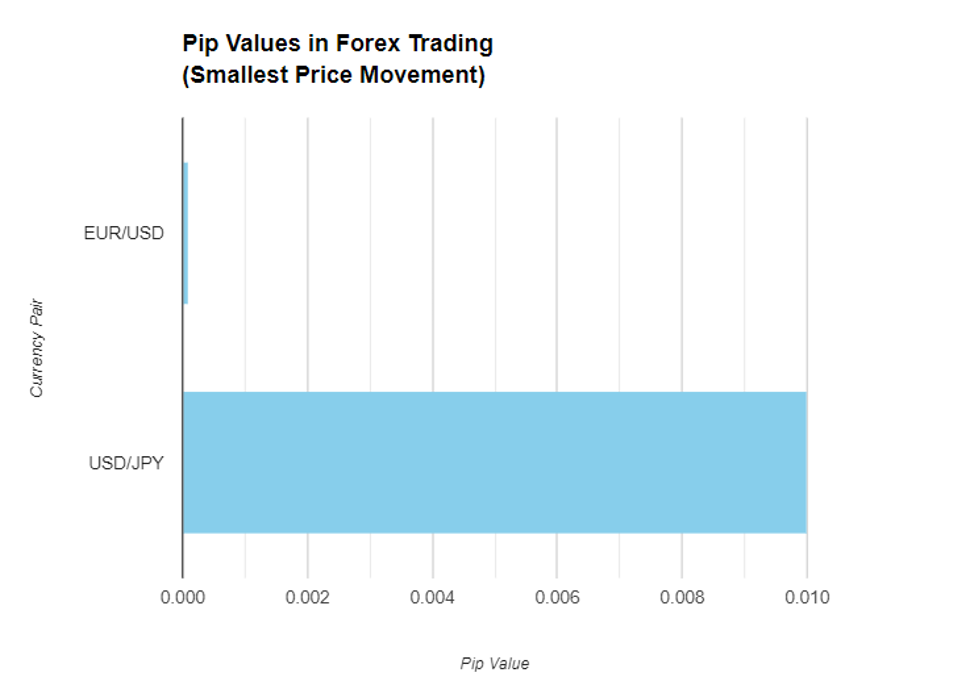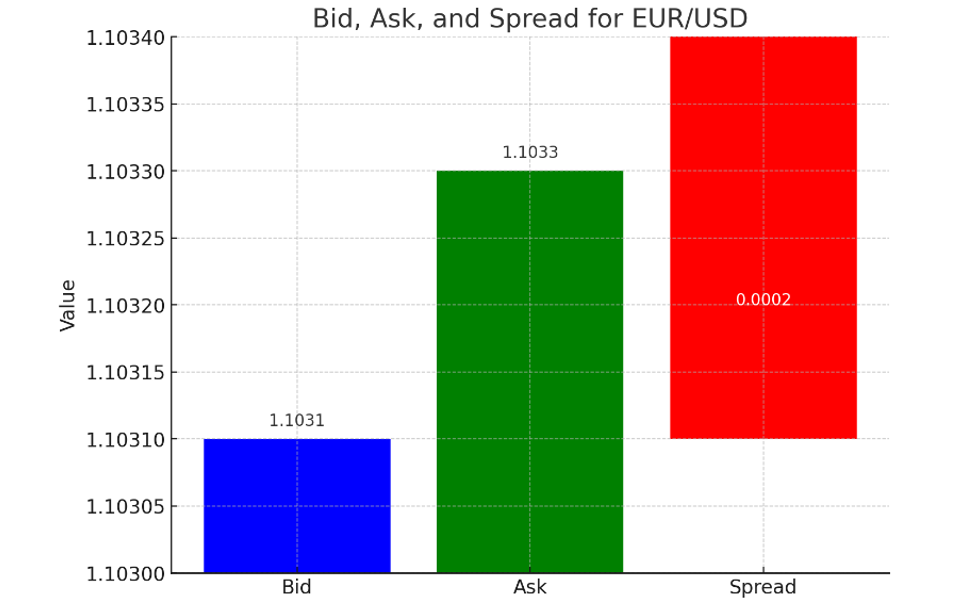Trading Course
First Steps in Forex Trading and Basic Terminology
- First Steps in Forex Trading and Basic Terminology
- Types of orders
- Advanced Orders
First Steps in Forex Trading and Basic Terminology
Getting started in forex trading involves understanding key concepts and terms to navigate the market effectively and make informed decisions.
Glossary
- Currency Pairs – Two currencies compared in the exchange rate.
• Things to Take into Consideration – Key factors for trading currency pairs.
• Types of Orders – Different ways to execute Forex trades.
• More Advanced Orders – Complex order types for strategic trading.
• P.S.M.L (Pip; Spread; Margin; Leverage) – Core risk and profit calculation concepts.
• Leverage Explained – Using borrowed capital to increase potential returns
Currency Pair
Currency pairs are undoubtedly the most fundamental concept in Forex trading. A solid understanding of their work, the factors influencing their movement, and the types of pairs (major, minor, exotic) are essential for building a strong foundation. While not as immediately practical as currency pairs, basic Forex terminology is crucial for effective communication and understanding market dynamics (refer to glossary on the page. It is also necessary to read currency price quotes.
Remember, in Forex, each currency is compared to another currency.
Base Currency – The main instrument of a Pair, the first currency to appear in a currency quote (on the left). The most popular bases are USD, EUR, GBP, AUD, and CHF.
Quote (Counter) – The Pair’s secondary instrument (on the right). One should ask, “How many Quote units do I need to sell to buy a single Base unit?”
| GBP/USD ⬇️ | + | 1.4135 ⬇️ |
| Base Currency | ➡️ | Quote Currency |
Whenever we execute a Buy order, we buy Base by selling Quotes (above—we buy 1 GBP by selling 1.4135 USD). When we execute a Sell order, we sell Base to buy Quote.
Forex quotes always consist of the Bid and the Ask prices. Brokers receive different Bid and Ask offers from the interbank market and pass the best offers to you, which are the quotes you would see on the trading platform.
Bid price – Best price at which we can sell Base to buy Quotes.
Ask price—The best price the broker offers for me to buy Bases in return for a Quote.
Exchange rate – Ratio of one instrument’s value to that of another.
- When buying currency, you operate an Ask Price action (you relate to the pair’s right-hand side); when selling currency, you do a Bid Price action (you relate to the pair’s left-hand side).
- Buying a pair means that we sell Quote units to buy Bases. We will do so if we believe that the value of the base will go up. We sell a pair if we believe the Quote’s value will rise. All Forex trading is done with currency pairs.
Example of A Forex Quote:
| EUR/USD | ||
| High 1,4150 | Low 1,3993 | |
| Bid | 2 | Ask |
| 140 64 | 1.40 66 |
The data is running constantly live. Prices are only relevant for the exact time they appear. Prices are presented live, moving up and down all the time. In our example, the Base is the euro (left). If we sell it to buy the quote currency (right, in our example, USD), we will sell EUR 1 in exchange for USD 1.1035 (Bid order). If we wish to buy euros in exchange for selling dollars, 1 euro will be 1.1035 dollars (Ask order).
The 2 pips difference between base and quote prices is called the Spread.
The non-stop changes in prices create profit opportunities for us traders.
Let’s take another example of a Forex quote:
| EUR/USD | ||
| Buy | ➡️ | Sell |
| 1.40 74 | ➡️ | 1.40 76 |
Like every currency pair, this pair contains two currencies: the euro and the dollar. It expresses the “dollars per euro” condition. Buy 1.1035 means that one euro buys 1.1035 dollars. Sell 1.1035 means that by selling 1.1035 dollars, we can buy 1 euro.
Lot – Deposit unit. Lots are the currency units we trade with. A lot measures the size of a transaction.
Examples to explain Lot:
A lot in Forex is like buying something in bulk. Instead of buying one apple, you’re buying a whole box of apples.
- The more apples in the box, the bigger the box (and the more it costs).
- In Forex, the more currency units in the lot, the bigger the lot (and the more money you need to trade).
There are different sizes of lots:
- Micro lot: A small box of apples.
- Mini lot: A medium-sized box of apples.
- Standard lot: A big box of apples.
The size of the lot you choose depends on how much money you want to risk and how confident you are about your trade.
Remember: Bigger lots mean bigger profits and more significant losses.
You can trade with more than one open lot if you wish (to reduce risks or raise the potential).
There are several different lot sizes:
- The micro lot size consists of 1,000 units of currency (for example, 1,000 US dollars), where each pip is worth $0.10 (assuming we deposit US dollars).
- Mini lot size is 10,000 currency units, with each pip worth $1.
- The standard lot size is 100,000 currency units, with each pip worth $10.
For a better understanding, see the Lot Type table
| 🔎 Type | 📈 Lots Size | 📉 Pip Value (assuming USD) |
| 📊 Micro Lot | 1,000 units of Currency | 0.10 USD |
| 💹 Mini Lot | 10'000 units of Currency | 1 USD |
| 💱 Standard Lot | 100'000 Units of Currency | 10 USD |
(It is important to note that the exact value of a pip can vary depending on the exchange rate of the currency pair being traded.)
Long position: Betting on Up
A long position is when you buy that currency, hoping its value will increase. It’s like betting that the currency’s price will rise. If it does, you make money.
Example: You think the Euro will get stronger than the US Dollar. You buy Euros, hoping to sell them later at a higher price.
Short position – Betting on Down
A short position is when you sell a currency, hoping its value will decrease. It’s like betting that the currency’s price will fall. If it does, you make money.
Example: You think the British Pound will get weaker compared to the US Dollar. You sell Pounds, hoping to repurchase them later at a lower price.
Let’s see an example: EUR/USD
| 🔎 Your Action | 🅰️ EUR | 🅱️ USD |
| Purchase 10'000 eurs at an EUR/USD excahnge rate of 1.1035 (Buy position on EUR/USD) | +10'000 | -10'350 |
| 3 Days later you exchange your 10'000 euro back into US Dollars at the rate of 1.1480 (Sell Position on EUR/USD) | -10'000 | +14'800 |
| Exit the trade with a 445 USD Profit (EUR/USD increase by 445 pips in 3 days. | 0 | +445 |
* 10,000 Euros x 1.1035 = $10,350
** 10,000 Euros x 1.1480 = $14,80
Things to take into consideration: Trading pairs
(Examples with List of concretions to keep in mind)
More Examples to understand better:
CAD (Canadian dollar)/USD- The American market is weakening, so we are buying Canadian dollars (placing a buy order).
CAD/USD
To accurately assess the potential strength of the Canadian dollar against the US dollar, consider monitoring these key economic indicators:
- Interest Rate Differentials: The Bank of Canada’s monetary policy compared to the Federal Reserve’s. A higher interest rate in Canada relative to the US can strengthen the CAD.
- Oil Prices: As Canada is a major oil exporter, fluctuations in oil prices significantly impact the Canadian economy and currency. Higher oil prices tend to strengthen the CAD.
- GDP Growth: Canada’s economic growth compared to the US. Stronger economic growth in Canada can boost the CAD.
- Trade Balance: Canada’s trade balance with the US. A surplus indicates a stronger CAD.
- Employment Data: Canadian employment figures can influence investor sentiment towards the CAD.
EUR/JPY
If we think the Japanese government will strengthen the yen to shrink exports, we will sell euros (place a sell order).
- Interest Rate Differentials: The European Central Bank’s (ECB) monetary policy versus the Bank of Japan’s (BOJ). A broader interest rate differential favoring the euro can strengthen the EUR/JPY.
- Economic Growth: The Eurozone’s economic growth compared to Japan’s. Stronger Eurozone growth can support the euro.
- Trade Balance: The Eurozone’s trade balance with Japan. A surplus can strengthen the euro.
Any statements or actions by the Japanese government regarding currency intervention

Types of orders
It is advised to focus mainly on “Stop Loss” and “Take Profit” orders (see below). Later, in the more advanced chapters, we will thoroughly study and understand how to use them in practice.
Buying/Selling execution at the best available market price (the live price quotes presented on the platform). This is the most basic, common order. A market order is an order you pass to your broker at real-time, current prices: “buy/sell this product!” (In Forex, product = pair).
An Example of when to use it: For immediate execution, but be aware of potential slippage
Limit entry order:
A Buying order beneath the actual price or selling order above the actual price. This order allows us not to constantly sit in front of the screen, waiting for this point to appear. The trading platform will automatically execute this order when the price reaches the defined price. Limit entry is very efficient, particularly when we believe this is a turning point. This means that, at that point, the trend will change direction. A good way to understand order is to think of it as setting your TV converter to record, e.g., “Avatar,” which will start in a few hours.
An example of when to use it is to enter a trade when a price level is breached, but it can also be triggered by market volatility.
Stop-entry order:
A buying order above the existing market price or a selling order beneath the market price. We use a stop-entry order when we believe a price movement will be in a clear, specific direction (uptrend or downtrend).
The two most important orders you need to learn if you want to become a successful trader:
Stop Loss Order:
A highly important and useful order! We recommend using it on every trading position you open! Stop loss eliminates the chance for extra losses beyond a certain price level. A selling order will occur as soon as the price meets this level. It is extremely important for traders not to sit in front of their computers because the forex market is very volatile. For instance, if you sell a pair and the price increases, the trade will close when it reaches the stop loss level and vice versa.
Example of when to use it: To protect your capital, but it might be triggered prematurely in volatile markets.
Take Profit order:
An exit trade order set in advance by the trader. If the price meets this level, the position will automatically be closed, and traders can collect their profits up to that point. Unlike a Stop-loss order, in this case, the exit point is in the same direction as market expectations. With Take Profit, we can ensure at least some profits, even if there is a possibility of gaining more.
Examples of when to use it: Based on support and resistance levels, chart patterns, or technical indicators, you can set a specific price target where you expect the market to reverse.

Advanced Orders
GTC:
Trading is active until you cancel it (Good till Cancelled). The trade will stay open until you manually close it.
GFD:
Good for the Day. Trade until the end of the trading day (usually according to N.Y. time). The trade will automatically be closed at the end of the day.
Tip: If you are not an experienced trader, do not try to be a hero! We advise you to stick with basic orders and avoid advanced orders, at least until you can open and close positions with your eyes closed… You must perfectly understand how they work to use them. It is important to first practice Take Profit and Stop Loss!
Volatility:
Level of instability. The higher it is, the higher the level of trading risk and the greater the winning potential as well. A liquid, volatile market tells us that currencies are changing hands in large volumes.
P.S.M.L
(Pip; Spread; Margin; Leverage)
When looking at a currency table on your trading platform, you will notice that the prices of the various currencies tend to jump up and down. This is called “fluctuation.”
Pip – the smallest price movement of a currency pair. One pip is the fourth decimal place, 0.000x. If EUR/USD rises from 1.1035 to 1.1040, in trading terms, it means 5 pips movement up. Nowadays, the brokers offer prices within a decimal of the pip, such as 1.10358… but we’ll explain this in detail below.

Keys to remember when looking at pips:
- Pip is the smallest price movement: It’s the basis for understanding price fluctuations.
- Fourth decimal place: Generally, a pip is the fourth digit after the decimal point.
- Example: A change from 1.1035 to 1.1040 is a 5-pip movement.
- Fractional pips (pipettes): Some brokers offer quotes with more decimal places, called pipettes. These represent even smaller price changes.
Any pip of any currency is translated into money and automatically calculated by the online trading platforms you trade on. The trader’s life has become simple! There is no need to calculate data by yourself. You just need to fit them into your wishes and expectations.
Remember: If a pair includes Japanese yen (JPY), then the quotation of the currencies goes 2 decimal places out to the left. If the pair USD/JPY moved from 106.84 to 106.94 we can say that this pair went up 10 pips.
Important: Some trading platforms present quotations showing five decimals. In these cases, the fifth decimal is called a Pipette, a fractional pip! Let’s take EUR/GBP 0.88561. The fifth decimal is worth 1/10 pip. However, note that most brokers do not show pipettes.
Profits and losses are calculated in terms of money and the “language of pips.” The Pips jargon is the dominant way of speaking when you enter the Forex traders’ room.
Spread – The difference between the buying price (Bid) and selling price (Ask).
(Ask) – (Bid) = (Spread). Take a look at this pair quotation: [EUR/USD 1.1031/1.1033]
Well, guess the spread in this case—2 pips, right? Just remember that the selling price of this pair is 1.1031, and the buying price is 1.1033.

This graph shows the difference between the buying price (Bid) and the selling price (Ask) for the EUR/USD currency pair.
- The blue bar is the Bid price (1.1031) – what you’d get if you sell euros.
- The green bar is the Ask price (1.1033) – what you’d pay if you buy euros.
- The red bar in between shows the Spread (0.0002), which is just the small difference between the Bid and Ask prices.
The Spread is what the broker earns from the transaction.
Margin:
The capital we must deposit in ratio to the capital we want to trade with (a percentage of the trading amount). For example, let’s assume that we deposit $10, using a 5% margin. This means that we can now trade for $200 ($10 is 5% of $200). Now, say we bought a euro in the ratio of [1 euro = 2 dollars]; we bought 100 euros with $200 with which we are trading. After one hour, the EUR/USD ratio went up from 2 to 2.5. BAM!
We have gathered a $50 profit because our 200 euros are now worth $250 (ratio = 2.5). By closing our position, we exit with $50 earnings, all with an initial investment of $10!! Imagine that in return for your initial deposits, you get “loans” (without having to worry about paying them back) from your broker to trade with.

Leverage:
The risk level of your trade. Leverage is the degree of credit you wish to get from your broker on your investment when opening a trade (position). The leverage you ask for relies on your broker and, most importantly, on whatever you feel comfortable trading with. X10 leverage means that in return for a $1,000 transaction, you can trade with $10,000.
Of course, you cannot lose a higher amount than the amount you have deposited into your account. Once your account reaches the minimum margin required by your broker, say $10, all your trades will close automatically.
The main task of leverage is multiplying your trading potential as a trader!
Let’s return to our example – a 10% rise in the Quote price will double your original investment ($10,000 * 1.1 = $11,000. $1,000 profit). However, a 10% lower quoted price will eliminate your investment!
Example: Say we enter long (remember? Long = Buy) on EUR/GBP (buying euros by selling pounds) at a ratio of 1. After 2 hours, the ratio suddenly jumps to 1.1 in Favor of the euro. In these two hours, we made a profit of 10% on our total investment.
Let’s put that into numbers: if we opened this trade with a micro lot (1,000 euros), then how on top are we? You guessed right – 100 euros. But wait; say we opened this position with 1,000 euros and a 10% margin. We chose to leverage our money x10 times.
Our broker provided us with an additional 9,000 euros to trade with, so we entered the trade with 10,000 euros. Remember, in these two hours, we gained 10% earnings, which has suddenly turned into 1,000 euros (10% of 10,000)!!
Thanks to the leverage we just used, we are now showing 100% profit on the initial 1,000 euros that we took from our account for this position!! Halleluiah! You see, leverage is great but also dangerous, so you must use it as a professional. Therefore, be patient and wait until you have finished this course before jumping in with high leverage.
Now, let’s check different potential profits according to different levels of leverage, all related to our numerical example:

Profits in Euros at various leverage
Hopefully, you better understand the outstanding potential to reach profitable investments in the Forex market. For us traders, leverage constitutes the widest window of opportunities in the world to make impressive profits on relatively small capital investments. After all, no bank in the world will allow you to legitimately invest $1,000 and collect your money after two months with 200% interest – cash out $3,000! Only the Forex market offers such opportunities; you will learn in-depth how to recognize them and turn them in your favor.
However, you must remember that while good leverage opens tremendous profit opportunities, incorrect leverage is dangerous for your money and may create losses. Understanding leverage is critical for your future success as a trader.
Let’s Make Forex Simple: Leverage Explained
Imagine you’re buying candy.
- Small Purchase: You have $1 and buy 1 candy. The candy price goes up, so you sell it for $1.10. You made 10 cents profit.
- Borrowing Money: You borrow $9 more, so you have $10 total. You buy 10 candies. The candy price goes up, and you sell all 10 for $11. You made a $1 profit.
That’s leverage! You used borrowed money to make more money. But, be careful! If the candy price goes down, you’ll lose more money if you borrow. So, remember, Leverage can make you money faster, but it can also make you lose money faster. Start small and learn before using lots of leverage.
